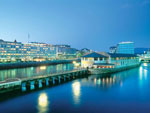A big green garden- the main Zoo of the capital with over sesquicentennial history -is spreading out in the center of Moscow. Today it is a home for over 8,000 animals of 3,000 species. Against the day of the official opening on 12 February 1864, the number of inhabitants did not exceed 200 wild animals of 80 specimens and 100 domestic animals.
At first, the Moscow Zoo was represented only by Russian fauna, and domestic animals were held for. At the same time it had rare for that time species: a rhinoceros, an alligator and parrots. Also, initially the Zoo was a subject for scientific research on acclimatisation of animals from other parts of the world in the conditions of northern climate of Russia, and actively co-operated on the given question with the foreign zoological organisations. And collection replenishment occurred due to various expeditions and gifts from Romanov's Imperial family. Many wealthy Muscovites made financial contributions to the Moscow Zoo development.
In the beginning of the 20th century the Zoo was strongly damaged during revolutionary fights in streets of Moscow. But after October revolution of 1917 the Zoo was nationalized and restored. Five years after, the Zoo received a new territory with spacious constrains instead of cages. Young Biologists Club of the Zoo that brought up many known biologists of Russia was also established at that time.
In days of the World War of 1941-1945 the Moscow Zoo was not evacuated and its staff stayed in the city to protect the animals 24/7. Both people and animals suffered much during the war time and yet they managed to survive. In 1970-1980s the Moscow Zoo began to fall into decay, as the city authorities considerably reduced financing.
The USSR disorder became a turning point in the history of the Zoo. Due to city authorities, the Moscow Zoo was reconstructed. For some years the Zoo changed: there were new departments, old constraints were modernised, supply was tailored.
Today, the first thing the visitors entering through the front entrance see is a large pond inhabited by natatorials, some of them are even listed in the Red Book. The pond also has a special territory for flamingo. In fact, the pond exists since the very first days of the Moscow Zoo.
The next thing the visitors see is a so-called ‘cat’s row’ displaying many specimens of wild cats. Cheetahs, very old inhabitants of the Zoo, are the Zoo’s pride. They breed well enough here, which is a rarity for the world zoos.
The constrains with representatives of canins are the next thing visitors see. The red wolf always sparkles a big interest as a vanishing breed listed in the Red Book.
The path brings the visitors to the pavilion ‘World of birds’. One can see a family of penguins who sometimes entertain visitors with their movements and jumps into water. There is a large diversity of the feathery of our planet: storks, cranes, parrots, ostriches, pheasants and other.
The following pavilion brings the visitors down to earth or even under the water. It is a delphinarium with the program of performances of dolphins and sturgeons, and also pools of the Californian sea lions and walruses. They can be observed both from above and through the glass walls of pools.
This is where the excursion in the old part of the Moscow Zoo ends, opened by a platform with benches in shades of trees and some open cafes. A new territory starts behind a small bridge and differs with the landscape design.
The open-air cage of polar bears and a terrarium are the most popular sections in the new Zoo. One can observe bears from a special platform or at the pool level where glass wall enables to watch the largest overland predator freely feeling in sea elements. And the terrarium of the Moscow Zoo has one of the largest collections of reptiles. One can see crocodiles, snakes, dragons, iguanas, lizards, water and overland turtles, and many other species - descendants of died out dinosaurs.
In addition, there is also the Children's Zoo where children can play with animals from fairy tales: hares, cubs of the wolves, foxes, pigs, and many others. Here children also can see domestic animals such as hens, turkeys, geese, goats, donkeys and even cows. The Children Zoo is an excellent opportunity to acquaint children with animals closes and to teach them not to be afraid of them and love them.
The new part of a Zoo has an additional entrance so the excursion can be held in the opposite direction. No matter what entrance you choose, one day would not be enough to see all variety of fauna presented in the Moscow Zoo. Therefore many of those who visited it at least once, come back here in a year or two. And the Zoo always welcomes the visitors who love and appreciate our nature.







